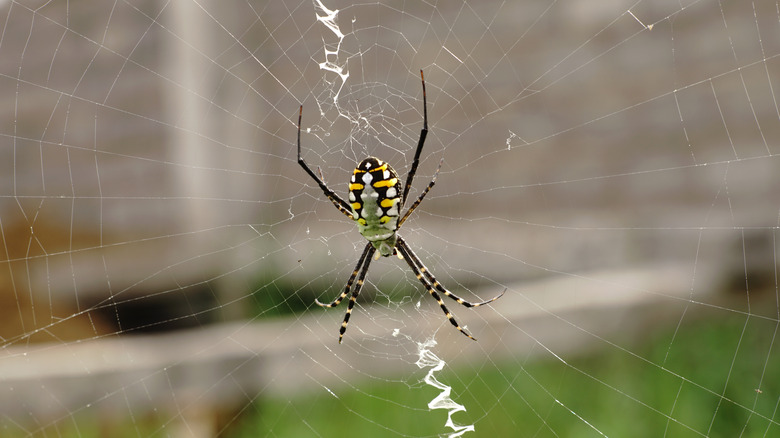The Beneficial Garden Insect That's Often Confused With Joro Spiders
In recent years, the news has been full of reports of invasive pests that range from annoying to dangerous. One such invasive pest was the Joro spider (Trichonephila clavata) which was first reported in the United States in 2014, with sightings in Georgia. Since then, these creepy crawlers have also appeared in Alabama, North Carolina, South Carolina, and Tennessee. While Joro spiders are spreading through the southeastern United States, gardeners may be mistaken when they think they've found one. Instead of the Joro spider, the arachnid they're likely spotting around their home is the black and yellow garden spider (Argiope aurantia), which can be beneficial for your garden.
The differences between Joro spiders and black and yellow garden spiders go beyond their appearance. Joro spiders are native to Asia, including China, Japan, North Korea, South Korea, Taiwan, Vietnam, and India. Black and yellow garden spiders are native to North America and can be found in Canada, the continental United States, Mexico, and Central America. Both spiders will only bite if threatened and if they do bite, the venom usually results in only a minor reaction.
Joro spiders create webs that are stronger and larger than other spider webs, which can mean trouble for gardeners if left alone as they can trap bees and other pollinators needed to help with plant reproduction. Alternatively, black and yellow garden spiders help control insects that can damage plants, making them a boon for your garden.
Black and yellow garden spiders are smaller and have different colored markings than Joro spiders
Joro spiders don't make the list of the most common spiders you may see in your home, which may be a reason to believe the arachnids hanging around your garden are not these pests. The most obvious sign that you're dealing with a black and yellow garden spider instead of a Joro spider is that they are smaller. Adult female black and yellow garden spiders (the largest of the species) usually measure up to 3 inches with their legs spread whereas the adult female Joro spiders often have a leg span up to 4 inches. Female Joro spiders also have larger bodies, which can grow up to 1.5 inches long while the yellow garden spider generally tops out at just over an inch in length.
If size doesn't help you identify the spiders in your yard, their coloring might. As their name indicates, black and yellow garden spiders (pictured on the right in the above image) have a black and yellow striped abdomen. Joro spiders (pictured on the left) also have yellow markings on their abdomen and black and yellow legs, but they are brightly colored, featuring gray and blue bands, as well as a red mark on the underside of the abdomen.
Here's how black and yellow garden spiders can benefit your garden
While Joro spiders may spell trouble for your garden, black and yellow garden spiders are among the beneficial spiders you may not want to kill. They create large, dramatic webs, featuring a zig-zag pattern that helps reinforce the structure. As a result, these spiders act as natural pest control within your garden, preying upon insects that can damage your plants, such as gnats, mosquitoes, aphids, grasshoppers, katydids, damselflies, and beetles. In addition to directly feeding on your plants, these pests can also interfere with vital pollinators that visit your garden, so black and yellow garden spiders help ensure effective, successful pollination.
Because the spiders eat so many of the usual garden pests, you likely won't need to rely on chemical pesticides, which is better for both your plants and the environment. Pesticides can also potentially kill pollinator insects that you don't intend to eliminate.


